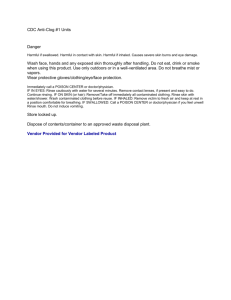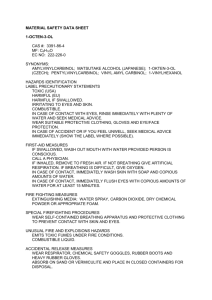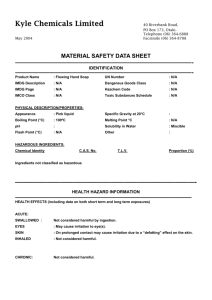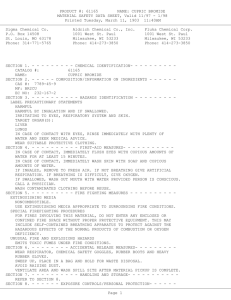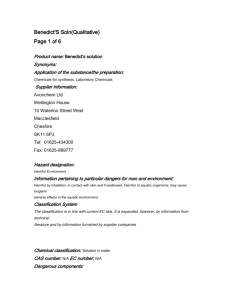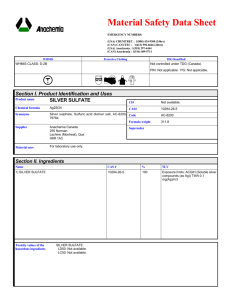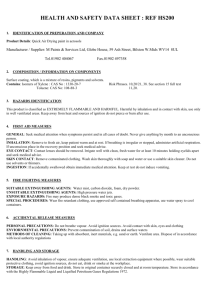trifluoroacetic acid (used in protein extraction)
advertisement
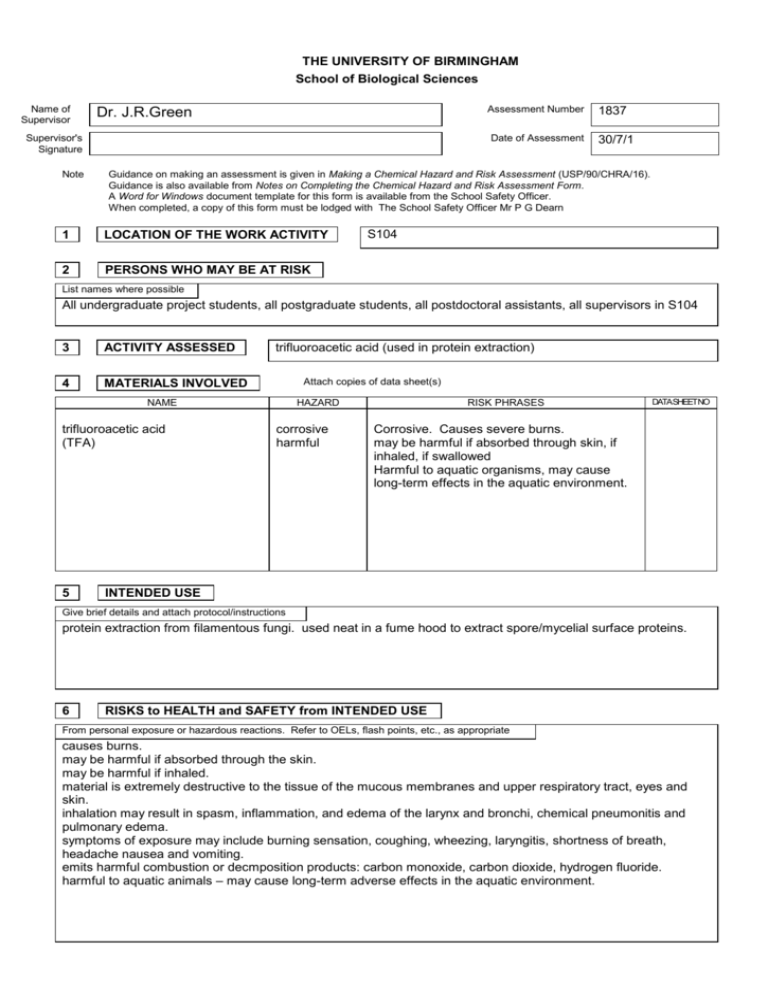
DATA SHEET NO THE UNIVERSITY OF BIRMINGHAM School of Biological Sciences Name of Supervisor Assessment Number Dr. J.R.Green Supervisor's Signature Note Date of Assessment 1837 30/7/1 Guidance on making an assessment is given in Making a Chemical Hazard and Risk Assessment (USP/90/CHRA/16). Guidance is also available from Notes on Completing the Chemical Hazard and Risk Assessment Form. A Word for Windows document template for this form is available from the School Safety Officer. When completed, a copy of this form must be lodged with The School Safety Officer Mr P G Dearn 1 LOCATION OF THE WORK ACTIVITY 2 PERSONS WHO MAY BE AT RISK S104 List names where possible All undergraduate project students, all postgraduate students, all postdoctoral assistants, all supervisors in S104 3 ACTIVITY ASSESSED 4 MATERIALS INVOLVED trifluoroacetic acid (used in protein extraction) Attach copies of data sheet(s) NAME trifluoroacetic acid (TFA) 5 HAZARD corrosive harmful RISK PHRASES DATASHEETNO Corrosive. Causes severe burns. may be harmful if absorbed through skin, if inhaled, if swallowed Harmful to aquatic organisms, may cause long-term effects in the aquatic environment. INTENDED USE Give brief details and attach protocol/instructions protein extraction from filamentous fungi. used neat in a fume hood to extract spore/mycelial surface proteins. 6 RISKS to HEALTH and SAFETY from INTENDED USE From personal exposure or hazardous reactions. Refer to OELs, flash points, etc., as appropriate causes burns. may be harmful if absorbed through the skin. may be harmful if inhaled. material is extremely destructive to the tissue of the mucous membranes and upper respiratory tract, eyes and skin. inhalation may result in spasm, inflammation, and edema of the larynx and bronchi, chemical pneumonitis and pulmonary edema. symptoms of exposure may include burning sensation, coughing, wheezing, laryngitis, shortness of breath, headache nausea and vomiting. emits harmful combustion or decmposition products: carbon monoxide, carbon dioxide, hydrogen fluoride. harmful to aquatic animals – may cause long-term adverse effects in the aquatic environment. 7 CONCLUSIONS ABOUT RISKS Is level of risk acceptable? Can risk be prevented or reduced by change of substance/procedure? Are control measures necessary? acceptable as small quantities are used in protected environment. use protective clothing. use good chemical practice. 8 CONTROL MEASURES Additional to Good Chemical Practice. Specify type or performance of control measure wear suitable protective clothing, gloves and eye/face protection. use only in a chemical fume hood. safety shower and eye bath. wash contaminated clothing before reuse. discard contaminated shoes. wash thoroughly after handling. do not breathe vapour. do not get in eyes, on skin, on clothing. avoid prolonged or repeated exposure. compatible chemical-resistant gloves. chemical safety goggles. faceshield. keep tightly closed in a well-ventilated place. store in a cool dry place. 9 INSTRUCTION/TRAINING Specify course(s) and/or special arrangements. none 10 MONITORING Performance of control measures, none Personal exposure 11 Health Surveillance WASTE DISPOSAL PROCEDURE avoid release to the environment. harmful to aquatic organisms – keep residue etc. in bottle which will be properly disposed of (via stores). 12 REVIEW Enter the date or circumstances for review of assessment (maximum review interval 5 years) 30/7/6 13 EMERGENCY ACTION AND CONTACTS WHERE NECESSARY TO CONTROL HAZARDS To stabilize situation eg spread absorbant on liquid spill; eliminate sources of ignition, etc. in case of fire, use noncombustible extinguishing media. emits toxic fumes under fire conditions. accidental release measures: wear self-contained breathing apparatus, rubber boots and heavy rubber gloves. cover with dry lime or soda ash, pick up, keep in a closed container and hold for waste disposal. ventilate area and wash spill site after material pickup is complete. CONTACT Jon Green PHONE Ex. 5574 Evacuation, protection for personnel involved in clean-up, Special First Aid TO PROTECT PERSONNEL if swallowed, wash out mouth with water provided person is conscious. call a physician immediately. if inhaled, remove to fresh air. if not breathing, give artificial respiration. if breathing is difficult, give oxygen. in case of skin contact, flush with copious amounts of water for atleast 15 minutes. remove contaminated clothing and shoes. call a physician. contamination of the eyes should be treated by immediate and prolonged irrigation with copious amounts of water. assure adequate flushing of the eyes by separating the eyelids with fingers. firefighting: wear self-contained breathing apparatus and protective clothing to prevent contact wth skin and eyes. CONTACT Jon Green PHONE Ex. 5574 Clean-up/decontamination TO RENDER SITE OF EMERGENCY SAFE contact a licensed professional waste disposal service to dispose of this material. dissolve or mix the material with a combustible solvent and burn in a chemical incinerator equipped with an afterburner and scrubber. CONTACT Jon Green PHONE Ex. 5574
